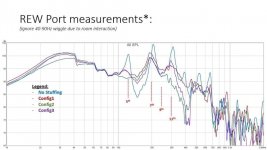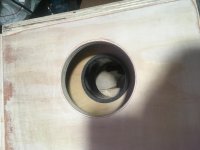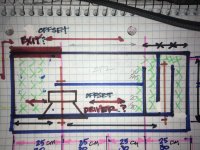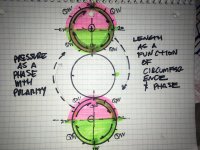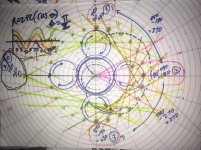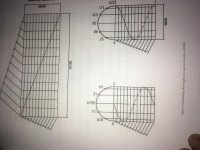Acoustic Energy & Surprising Ways To Harness It (Intro To Thermoacoustics) - YouTube
How many of us use this as a basis for our ‘pipe’ designs?! I have forever, but firever is less than two years, LOL?! Im still a newbie, but i refuse to crawl outta my former life as a tube / pipe trade and similar pastimes and fabricating in round metal cylinders and roll cages...
1/3-2/3 is the effective middle of a pressure wave inside a pipe if driven from there from its closed end, right? and f chasing that thru a pipe as folded segments of it, you can track phase and over a taoped pipes other entry point you can create a second pipe and its lemgth as 3 of those intervals with a third pipe in offset at that junction(of 3) , us that not the same cycle if given a pulse thats at a harmonic interval of say (80cm x3) and 240 cm total in each pipe, or 160, and 80) instead of (80, 80, 80). That can be 100cm in 300, as well as 90 in 270...e.tc,etc
a trip into horn response and it might seem it reveals (TH1: offset L12 pipe and (atc, Ap1 /ap2 as first pipe) , (L34,L45 as the second pipe).
Even paraflex as vrc, ap, has another prepipe segment, if used? But in these lengths or segmented pipes it all is very very close if you notice??
1-3 -2/3 in series as offset driver entry TL , 1/3-2/3 as seperates in compound horn entry , 1/3 2/3 as HFchamber and LF chamber in paraflex with a short exit and no offset drivers. And 2/3 1/3 in a roar if no offset driver or anything..
Csa changes and TS parameters aside, if the pipe is friendly to VAS and Qts for the Fs, then the idea is universal. start at an offset driver and you grab the furst hint at that csa and its length associated to a function that is then applicable all over the segmental geometries of any qw based design and folding segments in that window.
Not a claim or even considering it a possibility, but it certainly appears as such on the drivers i use and sims? Those are )0.35-0.6 qts, a firm/smaller in size Vas , a 30-40 hz Fs and a motor force and Re that are above average yet have a bit of cone weight to work?
How many of us use this as a basis for our ‘pipe’ designs?! I have forever, but firever is less than two years, LOL?! Im still a newbie, but i refuse to crawl outta my former life as a tube / pipe trade and similar pastimes and fabricating in round metal cylinders and roll cages...
1/3-2/3 is the effective middle of a pressure wave inside a pipe if driven from there from its closed end, right? and f chasing that thru a pipe as folded segments of it, you can track phase and over a taoped pipes other entry point you can create a second pipe and its lemgth as 3 of those intervals with a third pipe in offset at that junction(of 3) , us that not the same cycle if given a pulse thats at a harmonic interval of say (80cm x3) and 240 cm total in each pipe, or 160, and 80) instead of (80, 80, 80). That can be 100cm in 300, as well as 90 in 270...e.tc,etc
a trip into horn response and it might seem it reveals (TH1: offset L12 pipe and (atc, Ap1 /ap2 as first pipe) , (L34,L45 as the second pipe).
Even paraflex as vrc, ap, has another prepipe segment, if used? But in these lengths or segmented pipes it all is very very close if you notice??
1-3 -2/3 in series as offset driver entry TL , 1/3-2/3 as seperates in compound horn entry , 1/3 2/3 as HFchamber and LF chamber in paraflex with a short exit and no offset drivers. And 2/3 1/3 in a roar if no offset driver or anything..
Csa changes and TS parameters aside, if the pipe is friendly to VAS and Qts for the Fs, then the idea is universal. start at an offset driver and you grab the furst hint at that csa and its length associated to a function that is then applicable all over the segmental geometries of any qw based design and folding segments in that window.
Not a claim or even considering it a possibility, but it certainly appears as such on the drivers i use and sims? Those are )0.35-0.6 qts, a firm/smaller in size Vas , a 30-40 hz Fs and a motor force and Re that are above average yet have a bit of cone weight to work?
Last edited:
Nobody builds offset driver TLs anymore? Or played with that 1/3-2/3 affect by altering the csa and then having to find it? Like a voight pipe and driver at nearly 1/2? I was hoping to learn where exactly the harmonics end up in the folded pipes.
In general, it's a procession I've periodically posted and MJK posted some that were near enough identical based on what wave math he used:
Driver, vent offsets I use/recommend, i.e. at a pipe's odd harmonics: Z = ~ 0.217, 0.349, 0.424, 0.66, 0.714, 0.848
Another 'piece of the puzzle' I've never posted or even seen/heard of any mention is the 3rd dimension's impact on these 2D points. Have fun. 😉
Driver, vent offsets I use/recommend, i.e. at a pipe's odd harmonics: Z = ~ 0.217, 0.349, 0.424, 0.66, 0.714, 0.848
Another 'piece of the puzzle' I've never posted or even seen/heard of any mention is the 3rd dimension's impact on these 2D points. Have fun. 😉
Thats awesome!! Ive nailed the 0.349, and 0.848, with some skewed distances from it seems with csa expansion and whatnot. I Cant really tell unless i make the first one very very obvious...(by design.)
A friend made a nice illustration of his ‘chase’ with polyfil.
Ive cut a bypass straight from s1 hi pressure to(anywhere itll plumb to with pvc)
A friend made a nice illustration of his ‘chase’ with polyfil.
Ive cut a bypass straight from s1 hi pressure to(anywhere itll plumb to with pvc)
Attachments
GM, if i plot your numbers on a circle circumference as a part of a fundamental rotating around a circle with 90 degrees as Qws and the circle is pairrd with a polar opposite doing the same..
The reflected coordinstes result in the divisions per degree that divide at each into 3, 5, 3, and 0-2-1. At ‘noon’. They are then changed to cm instead of 1/2, 1/1, 1.5 and 2pi r. At tge fundamentals length. It would seem the pressure nuljs are almost perfect, but i need a sharp pebcil and accurate to truely admire the locations for what they are? It forms the positive sign wave, but its also a cardoid shaped function as the rotations per qw quadrant reveal?
The reflected coordinstes result in the divisions per degree that divide at each into 3, 5, 3, and 0-2-1. At ‘noon’. They are then changed to cm instead of 1/2, 1/1, 1.5 and 2pi r. At tge fundamentals length. It would seem the pressure nuljs are almost perfect, but i need a sharp pebcil and accurate to truely admire the locations for what they are? It forms the positive sign wave, but its also a cardoid shaped function as the rotations per qw quadrant reveal?
Attachments
Thats 5 (qw) at 450 degrees into 90 as a trip around twice is 720. So then Its 540 at 180(3) qw, 630/270/90 as 3 (qw) at 9 and 2/1/0 from 0,360/720 at noon.
Ploting it and spining it we see a funny shape of the creaent moon or an exlipse or the coupling affect of a group of subwoofers?????)
I hsre math at this level, its starts making the universe all run on the sane exact cumycje sbd phsucsl boundaries of math including infinity. Gabriels horn shape...
Ploting it and spining it we see a funny shape of the creaent moon or an exlipse or the coupling affect of a group of subwoofers?????)
I hsre math at this level, its starts making the universe all run on the sane exact cumycje sbd phsucsl boundaries of math including infinity. Gabriels horn shape...
Attachments
Last edited:
- Home
- Loudspeakers
- Subwoofers
- Thermoacoustics: but applied in pipe designed speakers?
